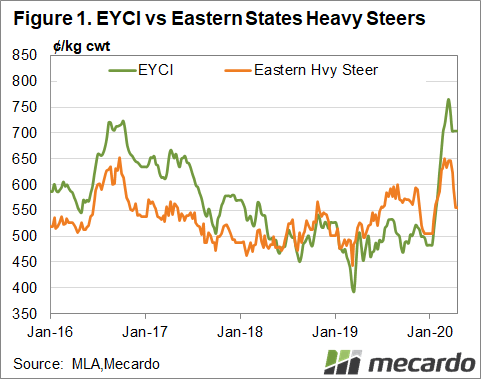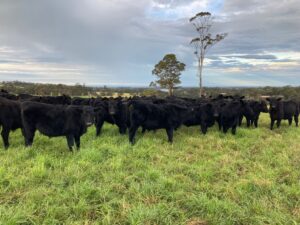Nothing seems to be able to dampen young cattle prices this year, as restockers continue to see the upside in filling their paddocks with beef. Competition at saleyards has ramped up with a seasonally good start to spring, helped along by finished prices holding pretty firm. Supply is seemingly on the decline, but some of this could be put down to processors slowing throughput having crunched the numbers and not come out on top.
The Eastern Young Cattle Indicator has dipped ever so slightly from its record highs at the end of August, down 13.50¢/kg over the past four weeks to close yesterday at 774.75¢. Historically, however, the indicator has been going nowhere but up. It is 288¢/kg higher year on year, or about 65 per cent. Working off of 5%, this equates to 418¢/kg liveweight. In comparison, the eastern states Heavy Steer Indicator is sitting at 364¢/kg, a rise of just 13%. Buying in at 300kg and selling at 580kg, this gives you a gross profit of $857 without price movement. Still a tidy return if prices hold and you’ve got the grass.
But genuine restockers, and opportunist backgrounders/finishers, might not be getting their young cattle for the EYCI price point in the south. If we look at the store yarding in Bairnsdale, Victoria, from Friday, Angus weaner steers 280-330kg were averaging 504¢/kg liveweight, while 200-280kg lots were up at the 567¢/kg average. Even heavier types, 330kg plus, were averaging 462¢/kg – a significant step up from the EYCI liveweight equation of 418¢/kg.
Online sales were closer to the mark last week, with AuctionsPlus reporting 280-330kg steers averaging 440¢/kg – however this was across all breeds. And if look at prime reports from the likes of Wagga Wagga, NSW, (which generally contributes close to 12% of the EYCI eligible cattle) average live weight steer prices were pretty spot on for feeders and processors – vealer steers 330kg plus to feeders averaging 425¢/kg, and 419¢/kg to processors. Look to where restockers were active, however, and you see prices for yearling steers 280-330kg, averaging 439¢/kg, and 330-400kg lots at 434¢/kg.
What does it mean?
It means if you are a restocker buying in cattle, stick to your budget to ensure the best chance of a healthy margin at the other end. Seasonally, things look like they will continue playing out in favour of the producer, as does supply, however the export market demand is still in the hands of a Covid-19 impacted global economy, which could result in unexpected disruptions at any time.
Have any questions or comments?
Key Points
- Young cattle returns maintain significant premium over finished prices.
- Margins still available for fattening cattle – if you can enter at average prices.
- Restockers paying a premium over feeders and processors.
Click on graph to expand
Data sources: MLA, Mecardo












